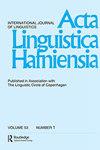From complex prepositions to complex subordinators: challenging generalizations
Q2 Arts and Humanities
引用次数: 0
Abstract
ABSTRACTThis paper presents a first approximation of the relationships within and between complex prepositions and complex subordinators from a cognitive vantage point. Because of the similarities between the two categories at the syntactic and functional levels of analysis, we first hypothesize the existence of a common productive schema that encompasses members of both classes within the framework of Construction Grammar. We then put forward a methodology developed in Diachronic Construction Grammar to analyze the within- and between-category constructional links in complex prepositions and complex subordinators in American English. We use multivariate quantitative methods to highlight the similarities and dissimilarities between the categories and make them visually identifiable. The application of this methodology to historical corpus data reveals that contrary to our expectations, complex prepositions form a relatively stable schema over time, without converging towards a common schema with the loosely connected complex subordinators under scrutiny.KEYWORDS: Complex prepositionscomplex subordinatorscorpus-based diachronic construction grammarAmerican Englishmultivariate statistical analysis Disclosure statementNo potential conflict of interest was reported by the author(s).Notes1 We use the terms ‘productive/-ity’ to refer to the tendency for a pattern to be used frequently to produce new types in a grammatical category.2 In this context, we acknowledge that the preposition does not impose the same construal of the situation: the noun phrase the rain projects a static frame of the object ‘rain’, whereas the clause invites a more dynamic construal of a continuous event.3 As was pointed out by an anonymous reviewer, the noun fact can be used with a relative clause in a variety of contexts due to its very broad and opaque meaning, especially in oral usage.4 In the remainder of this paper, examples culled from COHA will be referred to as follows.(example number) linguistic example (genre, year)5 We refer the reader to the study by Brems and Davidse (Citation2010) for simple statistical frequencies on the co-occurrence of complex subordinators with the discussed syntactic features.6 Here we use small capitals to refer to construction names.7 for fear of/that/Ø is also known to express conditional relations.8 for the sake of can also be used to express a benefactive relation to nominal complements.9 instead of is not discussed in this paper because it varies too much in its complementation profile.10 Brems and Davidse (Citation2010, 106) highlight that the non-finite nature of the complement clause is a facilitating factor for complex subordinator readings.11 We also acknowledge the fact that there is, to date, not any corpus big enough to allow a greater time depth for the analysis of low-frequency linguistic items such as CPs and CSs.12 For our purpose, we used R version 3.4.4 with the function MCA from the package FactoMineR and the function apcluster from the package of the same name.13 Note that the percentage of variation is displayed along the axes in our analyses for the sake of completeness only.14 Dimension 5 was excluded from the analysis as it focused on a single feature in a binary manner, specifically highlighting the unique use of lest in fear-related constructions. This represents a distinct case of complementation. Additionally, Dimension 5 reveals a genre continuum between NEWS (negative coordinates) and NF (positive coordinates). However, since Dimension 4 already demonstrated a significant genre continuum and the inclusion of lest as a category reduced interpretability by compacting data points, Dimension 5 was omitted.15 The grey-shading of the cells serves to highlight that distinct clusters are identified when the features are considered in isolation versus when they are combined. This underscores the significance of interactions among the features and the necessity of examining their combined impact for discerning meaningful distinctions between the clusters.16 Admittedly, the procedural meaning of prepositions makes it hard to find groupings of prepositions which are semantically similar and to which we can interchangeably resort to in the same context.Additional informationFundingThis work was supported by the Fonds De La Recherche Scientifique - FNRS [32704391].从复杂介词到复杂从属词:具有挑战性的概括
摘要本文从认知角度初步探讨了复杂介词与复杂从属词之间的关系。由于这两个类别在句法和功能分析层面上的相似性,我们首先假设存在一个共同的生产模式,该模式包含了结构语法框架内这两个类别的成员。在此基础上,我们提出了历时结构语法中发展起来的一种方法来分析美国英语中复杂介词和复杂从属语的范畴内和范畴间结构联系。我们使用多元定量方法来突出类别之间的异同点,使它们在视觉上可识别。将这种方法应用于历史语料库数据表明,与我们的预期相反,随着时间的推移,复杂介词形成了一个相对稳定的图式,而不是与松散连接的复杂从属词形成一个共同的图式。关键词:复杂介词;复杂从属关系;历时结构;美式英语;多元统计分析;注1:我们用“生产性”这个词来指在语法范畴中频繁使用一个模式来产生新类型的趋势在这种情况下,我们承认介词并没有施加同样的情境解释:名词短语the rain投射了一个物体“rain”的静态框架,而从句则引发了一个对连续事件的更动态的解释正如一位匿名评论者所指出的那样,名词fact可以在各种语境中与关系从句一起使用,因为它的含义非常广泛和不透明,尤其是在口头使用中在本文的其余部分中,从COHA中挑选的示例将引用如下。5我们建议读者参考Brems和Davidse (Citation2010)对复杂从属词与所讨论的句法特征共现的简单统计频率的研究这里我们用小写的大写字母来表示建筑的名称。/Ø也用来表示条件关系。for the sake of也可以用来表示与名义补语的有益关系。9 .代替,在本文中没有讨论,因为它在其补充概况中变化太大Brems和Davidse (citation, 2010, 106)强调,补语从句的非有限性质是复杂从属语阅读的一个促进因素我们也承认,到目前为止,没有任何语料库大到足以允许对低频语言项目(如cp和css)进行更大的时间深度分析出于我们的目的,我们使用了R版本3.4.4,其中包含FactoMineR包中的函数MCA和同名包中的函数apcluster请注意,在我们的分析中,变化的百分比是沿轴显示的,只是为了完整性维度5被排除在分析之外,因为它以二元方式关注单个特征,特别强调了唯恐在恐惧相关结构中的独特使用。这是互补的一个明显例子。此外,维度5揭示了NEWS(负坐标)和NF(正坐标)之间的体裁连续体。然而,由于维度4已经展示了一个重要的类型连续体,并且通过压缩数据点将最小作为一个类别的包含降低了可解释性,因此维度5被省略单元格的灰色阴影用于突出表明,当单独考虑这些特征时,可以识别出不同的集群,而不是将它们组合在一起。这强调了特征之间相互作用的重要性,以及检查它们的综合影响以辨别集群之间有意义的区别的必要性诚然,介词的程序意义使得我们很难找到语义相似的介词组合,并且我们可以在同一上下文中互换使用。本研究得到了Fonds De La Recherche Scientifique - FNRS的支持[32704391]。
本文章由计算机程序翻译,如有差异,请以英文原文为准。
求助全文
约1分钟内获得全文
求助全文
来源期刊

Acta Linguistica Hafniensia
Arts and Humanities-Language and Linguistics
CiteScore
0.90
自引率
0.00%
发文量
5
 求助内容:
求助内容: 应助结果提醒方式:
应助结果提醒方式:


